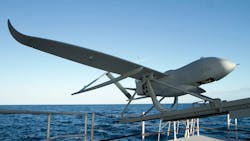Army orders small unmanned aerial vehicle (UAV) for Nigeria for reconnaissance and electronic warfare (EW)
REDSTONE ARSENAL, Ala. – U.S. Army unmanned aerial vehicle (UAV) experts needed a relatively small unmanned aircraft for communications and reconnaissance applications. They found their solution from Textron Systems Corp. in Hunt Valley, Md.
Officials of the Army Contracting Command at Redstone Arsenal, Ala., announced a $9 million order to Textron last week for an Aerosonde Mk 4.7 small UAV for Nigeria. The Aerosonde small UAV is for multi-mission expeditionary land- and sea-based operations.
Aerosonde weighs 80 pounds, has an 11.9-foot wingspan, can carry a 20-pound sensor payload, can fly as high as 15,000 feet, has a maximum range of 75 nautical miles, and can fly for as long as 14 hours. It for simultaneous day-and-night full-motion video, communications relay, and intelligence missions.
The Aerosonde MK 4.7 unmanned aircraft is designed for expeditionary land- and sea-based operations and equipped for simultaneous day and nighttime full-motion video, communications relay, signals intelligence (SIGINT), and a sensor payload in one flight.
Related: Military re-learns the importance of electronic warfare (EW)
The Textron Aerosonde small unmanned aircraft system (SUAS) has a Lycoming EL-005 heavy-fuel engine; and can accommodate multi-intelligence sensors, electronic warfare (EW), and communications payloads.
The Aerosonde MK 4.7 uses a hydraulic pneumatic launcher and net recovery system, and can launch from ground sites or from surface vessels.
On this order Textron will do the work in Hunt Valley, Md., and should be finished by September 2023. For more information contact Textron Systems online at www.textronsystems.com, or the Army Contracting Command-Redstone at https://acc.army.mil/contractingcenters/acc-rsa.

John Keller | Editor-in-Chief
John Keller is the Editor-in-Chief, Military & Aerospace Electronics Magazine--provides extensive coverage and analysis of enabling electronics and optoelectronic technologies in military, space and commercial aviation applications. John has been a member of the Military & Aerospace Electronics staff since 1989 and chief editor since 1995.

